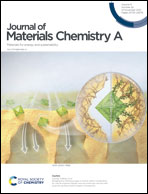Neural-network design of Li3VO4/NC fibers toward superior high-rate Li-ion storage†
Abstract
High-rate Li-ion storage of Li3VO4-based electrodes has been seriously hindered by modest reaction kinetics correlated with the particular challenge in morphology and structure regulation. A dimension-restrained strategy based on mixed electrospinning and a diffusion-controlled solid state reaction is firstly developed to design and synthesize neural-network Li3VO4/N-doped C fibers (NN-LVO/NC-Fs) with ultrafine LVO dots embedded in partially graphitized NC Fs and structure-enhanced network nodes. Benefitting from the unique architecture, the as-designed NN-LVO/NC-Fs exhibit outstanding high-rate performance with a high discharge capacity recovery of 763 mA h g−1 at 0.5 A g−1 after eight periods of rate performance testing up to 10.0 A g−1 over 730 cycles, and stable cycling over 1000 cycles with high capacities of 503, 451, 412 and 375 mA h g−1 at high currents of 2.0, 4.0, 8.0 and 10.0 A g−1, respectively. The ultrafine LVO dots, the partially graphitized NC Fs and the structure-enhanced network nodes promote continuously high capacitive charge storage, which contributes greatly to the outstanding high-rate performance. The diffusion reaction strategy for the design and synthesis of NN-LVO/NC-Fs serves as a reference for the construction of high-rate performance multiple-element compound electrodes.



 Please wait while we load your content...
Please wait while we load your content...